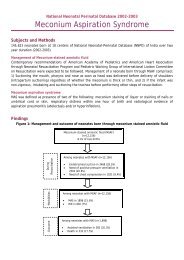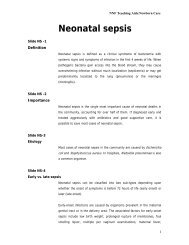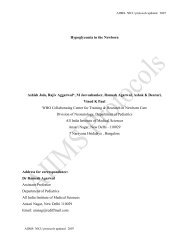Respiratory distress in - New Born Baby
Respiratory distress in - New Born Baby
Respiratory distress in - New Born Baby
You also want an ePaper? Increase the reach of your titles
YUMPU automatically turns print PDFs into web optimized ePapers that Google loves.
Slide RD-4, 5<br />
Causes of respiratory <strong>distress</strong><br />
Slide RD-6<br />
History<br />
Slide RD-7<br />
Exam<strong>in</strong>ation<br />
NNF Teach<strong>in</strong>g Aids:<strong>New</strong>born Care<br />
<strong>Respiratory</strong> <strong>distress</strong> <strong>in</strong> a newborn could be caused either by surgical or medical<br />
conditions. The common medical conditions are <strong>Respiratory</strong> <strong>distress</strong> syndrome<br />
(RDS), Meconium aspiration syndrome (MAS), Transient tachypnea of newborn<br />
(TTNB), pneumonia, aspiration, pulmonary hypertension, delayed adaptation,<br />
asphyxia and acidosis. Surgical conditions would <strong>in</strong>clude Pneumothorax,<br />
Diaphragmatic hernia, Tracheo esophageal fistula (aspiration), Pierre Rob<strong>in</strong><br />
Syndrome (upper airway obstruction due to glossoptosis), Choanal atresia and<br />
Lobar emphysema.<br />
While stabiliz<strong>in</strong>g a baby with severe respiratory <strong>distress</strong>, it is important to get a<br />
good history. We need to know the gestation and if the baby is premature it is<br />
important to know if antenatal steroids have been given or not. A history to<br />
determ<strong>in</strong>e the source of <strong>in</strong>fection would <strong>in</strong>clude history of premature rupture<br />
of membranes (PROM), if onset of <strong>distress</strong> is early. Aga<strong>in</strong> <strong>in</strong> early onset <strong>distress</strong><br />
one should f<strong>in</strong>d out the Apgar score and history of meconium sta<strong>in</strong>ed liquor.<br />
The importance of determ<strong>in</strong><strong>in</strong>g the time of onset of <strong>distress</strong> needs to be<br />
emphasized, as this may vary depend<strong>in</strong>g upon the etiology . It is important to<br />
know about the feed<strong>in</strong>g problems. Feed<strong>in</strong>g problems could be present <strong>in</strong> a<br />
severely <strong>distress</strong>ed baby. If feed<strong>in</strong>g problems are present such as chok<strong>in</strong>g or<br />
aspiration dur<strong>in</strong>g a feed, one could th<strong>in</strong>k of aspiration pneumonia as a<br />
possibility.<br />
To assess the severity of the <strong>distress</strong> the scor<strong>in</strong>g system given <strong>in</strong> Table 1 could<br />
be used. Cl<strong>in</strong>ical monitor<strong>in</strong>g is most important. An <strong>in</strong>creas<strong>in</strong>g score is more<br />
important than just an <strong>in</strong>crease <strong>in</strong> rate. It is also important to dist<strong>in</strong>guish<br />
between tachypnea and respiratory <strong>distress</strong>. Tachypnea is usually characteristic<br />
of a disease like transient tachypnea of newborn. Cardiac conditions and<br />
acidosis also usually manifest with tachypnea but could progress on to <strong>distress</strong>.<br />
2








